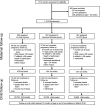A cluster randomised trial of cookstove interventions to improve infant health in Ghana
- PMID: 34452940
- PMCID: PMC8404442
- DOI: 10.1136/bmjgh-2021-005599
A cluster randomised trial of cookstove interventions to improve infant health in Ghana
Abstract
Introduction: Household air pollution from solid fuel combustion for cooking and heating is a leading cause of childhood morbidity and mortality worldwide. We hypothesised that clean cooking interventions delivered during pregnancy would improve child health.
Methods: We conducted a cluster randomised trial in rural Ghana to test whether providing pregnant women liquefied petroleum gas (LPG) cookstoves or improved biomass cookstoves would reduce personal carbon monoxide and fine particulate pollution exposure, increase birth weight and reduce physician-assessed severe pneumonia in the first 12 months of life, compared with control participants who continued to cook with traditional stoves. Primary analyses were intention-to-treat. The trial was registered with ClinicalTrials.gov and follow-up is complete.
Results: Enrolment began on 14 April 2014, and ended on 20 August 2015. We enrolled 1414 pregnant women; 361 in the LPG arm, 527 in the improved biomass cookstove arm and 526 controls. We saw no improvement in birth weight (the difference in mean birth weight for LPG arm births was 29 g lighter (95% CI -113 to 56, p=0.51) and for improved biomass arm births was 9 g heavier (95% CI -64 to 82, p=0.81), compared with control newborns) nor severe child pneumonia (the rate ratio for pneumonia in the LPG arm was 0.98 (95% CI 0.58 to 1.70; p=0.95) and for the improved biomass arm was 1.21 (95% CI 0.78 to 1.90; p=0.52), compared with the control arm). Air pollution exposures in the LPG arm remained above WHO health-based targets (LPG median particulate matter less than 2.5 microns in diameter (PM2.5) 45 µg/m³; IQR 32-65 vs control median PM2.5 67 µg/m³, IQR 46-97).
Conclusions: Neither prenatally-introduced LPG nor improved biomass cookstoves improved birth weight or reduced severe pneumonia risk in the first 12 months of life. We hypothesise that this is due to lower-than-expected exposure reductions in the intervention arms.
Trial registration number: NCT01335490.
Keywords: child health; environmental health; epidemiology; randomised control trial.
© Author(s) (or their employer(s)) 2021. Re-use permitted under CC BY-NC. No commercial re-use. See rights and permissions. Published by BMJ.
Conflict of interest statement
Competing interests: None declared.
Figures



References
-
- Mortimer K, Ndamala CB, Naunje AW, et al. . A cleaner burning biomass-fuelled cookstove intervention to prevent pneumonia in children under 5 years old in rural Malawi (the cooking and pneumonia study): a cluster randomised controlled trial. Lancet 2017;389:167–75. 10.1016/S0140-6736(16)32507-7 - DOI - PMC - PubMed
Publication types
MeSH terms
Associated data
Grants and funding
LinkOut - more resources
Full Text Sources
Medical
Miscellaneous
